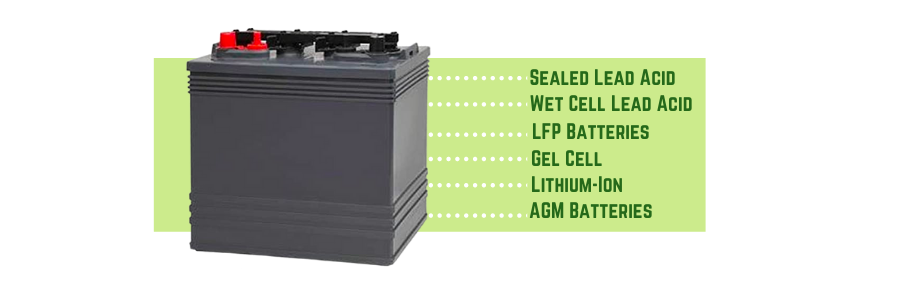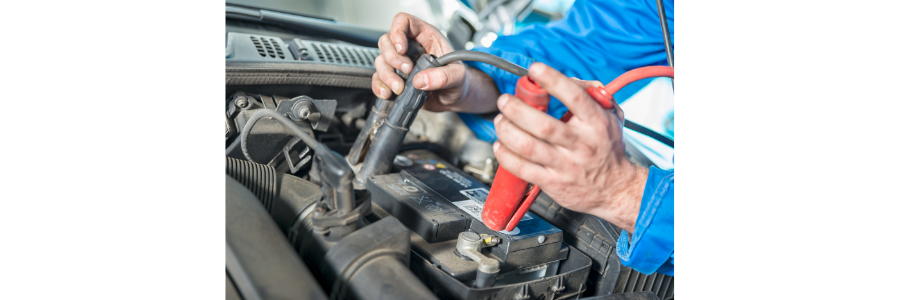How To Buy Golf Cart Batteries

!!!!DISCLAIMER!!!! This site may contain Amazon & other affiliate links.
This means if you click on one of the product recommendation links, this site may receive a small commission. This is at no extra cost to you and may include exclusive discounts when possible. This helps support this site and allows us to keep making content like this. Thank you for your support!
The following article is all about golf cart batteries and what you need to know before purchasing one. We will cover all the different types of golf cart batteries, including their differing energy storage capacities. You will also learn how to calculate the amp hours you will need for your particular battery pack.
To help you learn even more about the best way to find the correct battery for your golf cart, we have also included a discussion about the different ways to get your new batteries as well.
Finally, there is a section that discusses how to properly maintain and care for your new golf cart battery.
Types of Batteries
Learn about the different types of batteries available. These include wet cell lead acid, sealed lead acid, gel cell, and lithium-ion batteries.
Also, learn about the differences between normally-sealed lead-acid and valve regulated (or VRLA) configurations, as well as what AGM actually means.
Amp Hour Rating
Learn about determining the amp hour rating of the battery you need to buy. Determine your current draw, take into account the depth of discharge rate, and other factors to determine the size of battery you will need.
Battery Maintenance
Learn everything you need to know about proper golf cart battery maintenance. Procedures such as equalizing your batteries are discussed as well as tips to preserve your battery’s life and performance over a long period of time.
Understanding the Types of Golf Cart Batteries Available
There are five major types of batteries commonly used in golf carts today. These include wet cell lead acid, sealed lead acid, gel cell, lithium-ion, and AGM or Absorbed Glass Mat batteries.

Wet Cell Lead Acid
This is the most common and traditional type of lead-acid battery used in golf carts today. The wet cell refers to the fact that these batteries maintain a liquid state within their cells.
These batteries will self-discharge over time, but they are shallow cycle batteries which means that they can be fully discharged with little or no damage incurred.
Do not let your new wet cell golf cart battery sit around for a long time before installing it in your golf cart. The reason is that lead-acid batteries self-discharge even without a load on them (i.e., they make their own electricity).
The more time the battery spends without a load on it, the more energy it will self-discharge and the weaker it will get.
Sealed Lead Acid
These batteries are essentially sealed versions of wet-cell lead-acid batteries. This means that they are fully encapsulated, which prevents the liquid from spilling.
If you don’t need to install your batteries in a hazardous environment (e.g., below or above ground, near children or pets, etc.), then sealed lead acid batteries are a great option for you.
The biggest difference between sealed lead-acid batteries and wet-cell lead-acid batteries is that sealed lead acid batteries are maintenance-free and do not require any upkeep (i.e., water levels need to be monitored).
Gel Cell
Gel cell golf cart batteries are a newer type of golf cart battery. They are designed with a gel electrolyte which allows the battery’s sulfuric acid to remain in a semi-solid state.
The result is that gel cell batteries have higher charge acceptance rates and better overall performance than wet-cell lead-acid batteries.
They also do not require any maintenance, which makes them popular choices for hybrid and electric vehicle applications.
Like sealed lead-acid batteries, they are also highly recommended for installation below or above ground as well as in hazardous environments where the chance of spills or leaks is very low. Because they do not need to be maintained, however, there is no chance of spilling any fluid either.
Lithium-Ion
Lithium-ion batteries are becoming increasingly popular despite the fact that they are generally more expensive than other lead-acid batteries. What makes lithium-ion batteries so popular is their high charge acceptance rate, long life, and their ability to be recharged very quickly.
Lithium-ion batteries also do not need to be maintained, which makes them a great choice for use in areas where spills or leaks could occur (e.g., below ground, in corrosive atmospheres, etc.).
Like gel cell golf cart batteries, lithium-ion golf cart batteries are maintenance-free and can be used for installation below or above ground without having to worry about potential issues with fluid spills or leaks.
AGM Batteries
AGM or Absorbed Glass Mat batteries are a type of hybrid battery that combines the best features of gel cell and sealed lead-acid batteries.
Although they have an electrolyte that consists of little more than a gelatin-like substance called silica, their electrolyte is still inside the battery. This means it is not exposed to the outside elements, which makes them very similar to sealed lead acid golf cart batteries.
As with gel cell golf cart batteries, however, there is no chance for fluid spills, and therefore AGM golf cart batteries do not need to be maintained (in fact, most manufacturers recommend against it).
Although AGM batteries are maintenance-free, they also have a higher charge acceptance rate than standard and gel cell batteries which means they have a higher power output.
They do tend to be slightly heavier than sealed lead-acid golf cart batteries, but their performance will generally be better than other types of lead-acid golf cart batteries in almost all applications.
LFP Batteries
Lithium Iron Phosphate or LFP batteries are a newer type of golf cart battery currently gaining popularity in the battery industry. Although they cost more than traditional lead-acid golf cart batteries, they provide numerous benefits and may be worth the extra cost to some people.
The main benefit of lithium iron phosphate batteries is that they are more environmentally friendly than other types of lead-acid batteries.
They do not use any acids or other toxic chemicals in their construction and can be recycled or disposed of in landfills without causing any environmental damage.
Another benefit of lithium iron phosphate batteries is their high charge acceptance rate which means they will last longer and can be recharged very quickly.
They are also lighter weight than most other types of lead-acid golf cart batteries, which means they will be easier to install as well as easier to move around if need be.
Despite the fact that they are more expensive, lithium iron phosphate batteries have become very popular in recent years. Many golf cart manufacturers now make their golf carts with lithium iron phosphate batteries as standard rather than using traditional lead-acid batteries.
Choosing Between Sealed Lead Acid, Gel Cell, and LFP Golf Cart Batteries
No matter which type of lead-acid golf cart battery you choose, you should always try to purchase a brand new battery rather than a used one.
Although it may be tempting to save some money by buying a used battery, there is no guarantee that it will have the power and capacity to meet your expectations.
In addition, lead-acid batteries will not last forever, and it is always possible that a used battery may have been damaged in transport or storage.
If you are going to invest in a new battery, always try to get an OEM (Original Equipment Manufacturer) brand rather than a generic or aftermarket one.
A quality OEM golf cart battery will be considerably more durable and able to perform far better than a generic or off-brand double-A battery.
You also want to make sure you purchase your new golf cart battery from a reputable company so you can be assured of the quality of the product. It is always a good idea to read customer reviews of any golf cart battery you are considering purchasing.
If the company that manufactures the battery does not have any reviews or testimonials on its website, this should be a red flag. A reputable vendor will have plenty of positive reviews concerning the durability and overall quality of its products.
Once you purchase your new battery, you need to make sure it is installed correctly and maintained properly, so it lasts as long as possible. Always make sure you keep it charged and store it accordingly so that it falls down to its optimum performance level when you need it most.
Amp Hour Rating
Another thing you will need to consider is the amp hour rating of your battery, which will tell you how much energy it can hold. More amp hours means a longer running time.
You will want to make sure your battery has plenty of amp-hour capacity in order to power everything on your golf cart, such as lights, GPS, etc.
Golf Cart Battery Maintenance
Once you have purchased a new battery for your golf cart, there are some things that need to be done to ensure peak performance and long life.
As long as you maintain your battery properly, then it should last for a very long time. Here are some basic steps you can do to keep your battery in good working order.

Initial Charging
A brand new battery will need to be charged for 8 hours the first time it is used.
The reason for this is that new batteries come with a reduced charge state due to sitting on the shelf or in storage. The golf cart battery charger should read 14 volts at first. If you use this on a 12-volt battery, then go by the amps and not the voltage.
Never charge a deep cycle, flooded, or gel cell battery with a constant voltage charger, and never charge it overnight.
Deep cycle or marine batteries take long periods of time to bring up to full charge. This is why they are designed differently than regular car batteries.
If you have purchased a sealed fusion cell battery, then you will need to find out from the manufacture how long it should be charged at a time and how long to float charge it for storage.
Equalize the Electrolyte
If you have a wet cell lead-acid battery and it has just been charged, then you will need to equalize the electrolyte just like when you first started charging it. This is done by fully discharging the lead-acid battery until the specific gravity readings of each cell fall below 1.20.
To do this, you will want to unhook your charger from the battery and run all of your electrical equipment until it no longer runs. Then turn off all of your onboard accessories and lights.
After that, it is recommended to unhook your positive cable from the battery and then run the vehicle until it slows down. Then carefully hook up the positive cable to the battery again.
Next, unhook your negative cable and let it run until it stalls out again. Then hook up your negative cable to the battery again.
This process will take about 10 hours for a new wet cell golf cart battery if done correctly. If you have a lot of accessories and lights on your golf cart, it may take longer.
Clean the Battery Terminals
You want to make sure you clean the battery terminals before you hook the battery up to your golf cart. If there is rust or corrosion on the battery terminals, then the wire will not be able to fully make contact and charge your golf cart battery.
Use a wire brush or sandpaper to clean off any rust or corrosion on your battery terminals. Be careful while doing this, as a loose connection will cause some sparks.
There is also a bleach, baking soda, and water mixture you can use to clean any dirt or corrosion off of your battery terminals. You want to make sure the battery terminals are completely dry before attaching the wire to them.
Clean the Battery Corrosion
If there is any corrosion on the battery, it should be cleaned off with a wire brush or sandpaper and then wiped down with an alcohol solution. You should not use a wire brush to clean the battery terminals as it will leave scratches on the battery casing.
If you need to remove battery terminals, then you can use a pair of vice grips and bolt cutters. If there is any corrosion or dirt on the battery terminal, then spray some WD40 into the terminal and let it sit for a while.
Do you know how to test your golf cart battery? This video is for you:
Battery Maintenance Summary

Try to avoid overcharging your battery. Overcharging a battery will shorten the lifespan of the battery and may cause it to become stale or sulfate.
Do not completely discharge your lead acid golf cart battery, as this will damage the internal plates and cause permanent damage to the overall capacity of the batteries.
Never store a fully charged or discharged lead-acid golf cart battery. This will also cause permanent damage to the internal plates of the golf cart battery.
You should try to store your golf cart in a climate-controlled environment. This will help prevent battery damage from temperature and humidity changes.
Wrapping Up
One thing to keep in mind before you invest in a new golf cart battery is that it can be expensive. If possible, try to buy a used one from someone you know or on eBay rather than purchasing a new one from the local store.
Buying a used golf cart battery may save you money but make sure it’s not been damaged or will not work properly before purchasing it.
The main thing to remember is that the type of battery you choose will depend on your specific needs. If you want more power or more amp hours for a maximum amount of time, then lithium iron phosphate or AGM batteries are your best bet.
You may also want to consider LFP batteries as they are lightweight and environmentally friendly.
If simplicity is what you are looking for, then sealed lead-acid golf cart batteries are a great option. They are the least expensive and can be used for club carts, small vehicles, or electric golf carts.
No matter what type you choose, however, you should always try to purchase a new battery rather than a used one. Used batteries will likely have been damaged during shipping or storage and may not have as much power and amp hours as you need.
When installing your new battery, make sure it is securely connected so it cannot move around while in transit or while driving down the fairway. You also want to make sure it is placed in a safe, secure location, so it does not fall off while you are driving or crashing into other vehicles.
Final Thoughts
No matter which type of lead-acid golf cart battery you choose, you should follow the basic steps outlined above to make sure your battery is in good working order and will last as long as possible. If you take care of your battery and don’t overcharge it or over-discharge it, it will last a very long time.
Now that we have talked about the different types of golf cart batteries and how to maintain them, you should be ready to make an informed decision when choosing the best battery for your needs. For more information about Golf Carts and Troubleshooting, Click this article.
Frequently Asked Questions
There are many things you should know and consider when buying a new golf cart battery. Here are some of the most frequently asked questions about buying golf cart batteries:
1. How Much Should I Spend On A Golf Cart Battery?
The price of a golf cart battery will depend on what type of battery you need and where you purchase it from. You can find some used golf cart batteries on eBay for a great price; however, you never know if they were damaged in shipping or if they will work properly after you install them.
If possible, try to spend around $500 for the best quality battery. This type of battery will be able to meet your demands and last as long as possible.
If you are looking for something less expensive, then there are plenty of reliable batteries at a lower cost that will work just fine for your needs.
2. Can I Use Any Type Of Battery For My Golf Cart?
The type of battery you choose will mostly depend on what you want out of the battery. If you are looking for a battery that can give you the most power and the longest driving time, then lithium iron phosphate or AGM batteries are probably your best bet.
If you are looking for a low-cost, easy to maintain golf cart battery, then sealed lead acid batteries may be your best option.
These types of batteries are also available in a wide range of sizes, making them a good option for electric-powered vehicles, small cars, and club carts.
3. What Is The Difference Between Lithium Iron Phosphate And AGM Batteries?
The difference between lithium iron phosphate batteries and AGM batteries is that lithium batteries are more powerful but also more difficult to maintain. They work best for applications where there is heavy usage, and these batteries can last up to five years.
AGM golf cart batteries, on the other hand, are less powerful but easier to maintain. They tend to last up to three years in normal use, which may be all you need for your purposes.
Finally, Lithium Iron Phosphate batteries are based on the quality of components used to create them.
For example, a lithium iron phosphate battery will contain lithium iron phosphate cells, nickel cobalt aluminum oxide cells, and not just nickel-cobalt. The quality of this battery is very high and lasts longer than any other type of golf cart battery.
4. What Is The Difference Between Sealed Lead Acid And Flooded Batteries?
The main difference between sealed lead-acid batteries and flooded lead-acid batteries is that sealed lead-acid batteries have no gas needed, while flooded lead-acid batteries allow gases to escape.
Flooded lead-acid batteries are older and provide less power when compared to sealed lead-acid batteries. There are, however, fewer maintenance issues with flooded lead-acid batteries.
Sealed batteries, on the other hand, require the maintenance of adding distilled water to the cells during charging. If you don’t do this, then the battery will overheat and explode.
5. What Is The Difference Between Wet Cell And Gel Cell Batteries?
The biggest difference between wet cell and gel cell is that wet cell has a liquid electrolyte while gel cell has a gelled electrolyte that is dry and can be recharged by overcharging it for several hours before it naturally discharges again.
Gel cells are also safer than wet cell batteries and can be placed in any position, while wet cell batteries must be upright to prevent an explosion.
6. What Is a Golf Cart Battery
A golf cart battery is a type of rechargeable battery that is used in a golf cart. Because the batteries are expensive and have a limited life expectancy, they must be maintained in order to maximize their use.
7. How Long Does A Golf Cart Battery Last
The lifespan of most batteries depends on how often you use your golf cart, what climate conditions it is exposed to, and the quality of the battery itself.
You can expect that the average lithium battery will last 2-5 years, while most lead-acid batteries will last 5-10 years before they need to be replaced.
8. How to Charge a Golf Cart Battery
Charging a golf cart battery correctly is important if you want it to last as long as possible. The best way to charge it is in two steps:
1. Slow Step Charging: This involves putting the battery on a charger between 10% – 15% of its capacity for 10-20 hours. This must be done slowly; otherwise, the battery may become damaged or injured.
2. Absorption Charging: Once the slow charging process is complete, then begin absorption charging which involves putting the battery on a charger until it reaches about 80% of its capacity (also known as full charge).
9. How to Maintain Your Battery
There are several different ways to properly maintain your battery. You will want to make sure that you are keeping up with these steps if you want your battery to last as long as possible.
1. Check Voltage: You should always check the voltage of your battery once per month. If it is below 12 volts, then you should charge it as soon as possible.
2. Clean Terminals: Before charging, clean off the terminals of your battery and then apply a thin layer of grease or petroleum jelly to prevent corrosion and ensure proper connection between the terminal posts and the cable clamps.
3. Check & Add Water/Acid: You will want to check the water/acid levels in your battery on a regular basis. If it is low, then you will need to add some more of both (separately).
4. Don’t Over-Charge: Avoid overcharging your battery as this can be just as bad for it as not charging it enough. Be sure to check the voltage regularly and stop charging once it reaches 80%.
10. How to Get the Most Out of Your Battery
While you can’t necessarily prolong a battery’s life, you can get it to last longer if you take care of it properly. Here are several tips for you to follow.
1. Avoid Overcharging: Try not to overcharge your battery as this will damage it over time. Once you reach 80%, then stop charging.
2. Store Properly: If possible, store your batteries in a cool area that is at least 50 degrees Fahrenheit with at least 5% humidity. This may mean that they should be kept inside instead of outside in extreme weather conditions or when not being used for long periods of time.
3. Check the State of Charge: Before you use your battery, be sure to check how much charge is available in it. While doing so, avoid excessive physical activity or stress that could trigger an explosion.
4. Avoid Extreme Temperatures: Keep your batteries away from extreme temperature conditions (such as extreme heat and cold), which can damage them over time.
11. How to Test Your Golf Cart Battery
There are several ways that you can test a golf cart battery to see whether or not it needs to be replaced. These tests will help you determine the state of charge of the battery and verify whether or not it is still functioning properly.
1. If you suspect that the battery isn’t holding a charge, then you can put it on a charger for one hour. Once the hour is up, you will want to measure the voltage across the terminals. If it is less than 12 volts, then it will need to be charged before use.
2. The second test that you can perform is known as the load test. This involves putting a load of around 50 amps on your battery for 20 seconds and then checking the voltage reading with a voltmeter or hydrometer after 20 minutes have passed since starting this test.
3. The last test that you can perform is known as the voltage drop test. This involves starting your cart and then recording the voltage reading across the terminals after a couple of minutes have passed (approximately 10).
Then repeat this step after 30 minutes. If there has been a voltage drop of 0.1 volts, then the battery will need to be replaced.
Here is a video showing how to test a golf cart battery:





